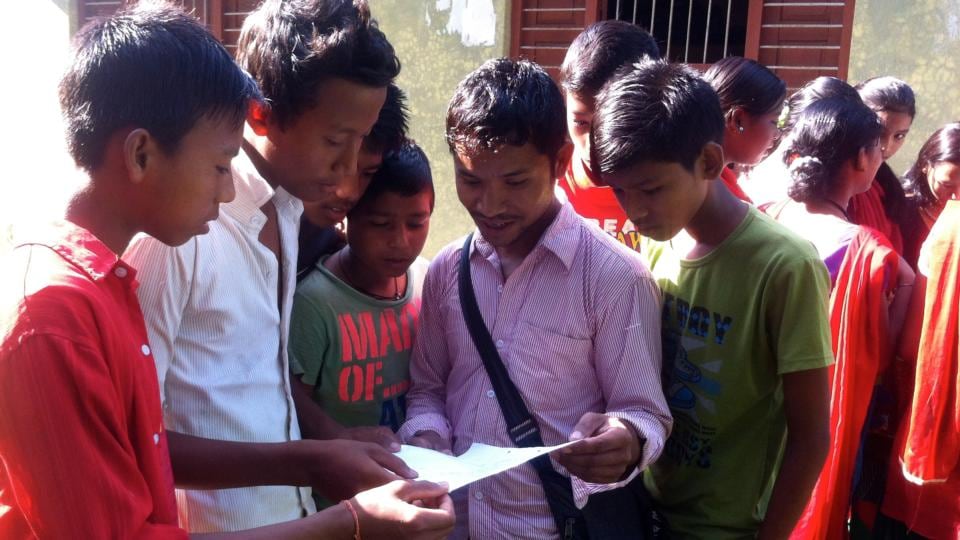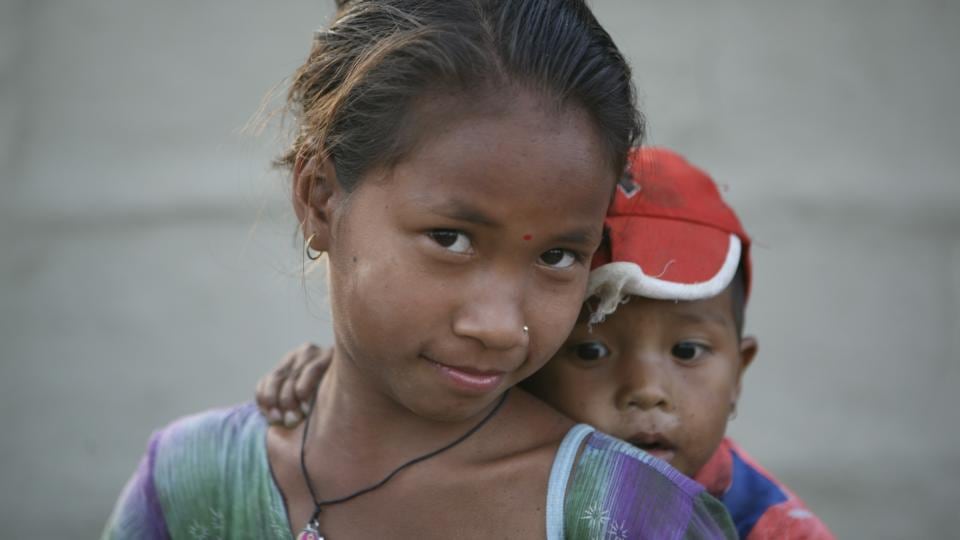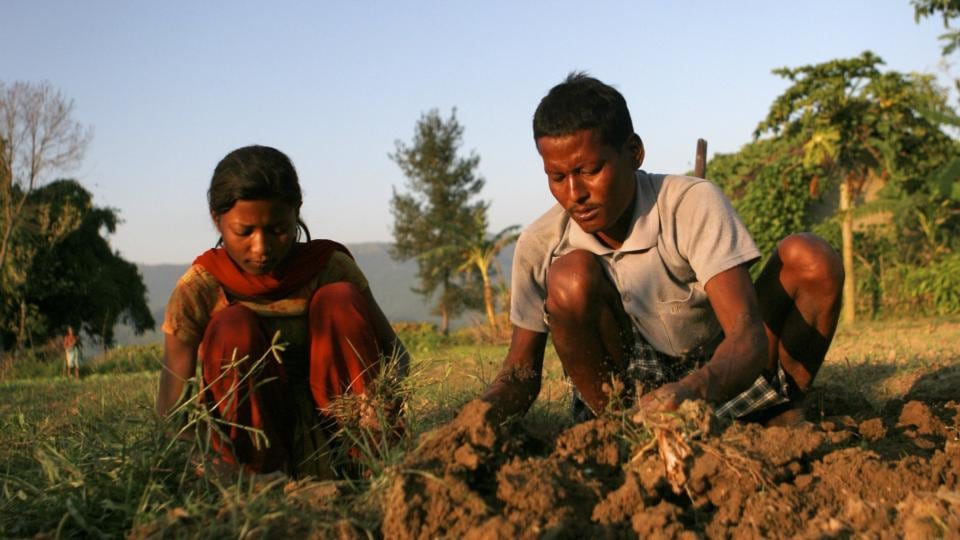Nepal is at either a turning point or a standstill. Because politicians failed to meet last year's deadline for drawing up a constitution, the chief justice is the prime minister, overseeing elections next month. Frequent strikes paralyse Kathmandu, the sprawling capital. The porous border with India is one of the world's busiest slave-trafficking routes.
Nobody knows exactly how many Nepalese women and girls are trafficked to India and forced into prostitution each year. It could be as many as 10,000. But one of Nepal's problems, the terrible legacy of kamalari practices, whereby young girls are sent into domestic slavery, is gradually being overcome.
Plan, the charity that promotes children's rights and hopes to end child poverty, is trying to eradicate the practice. With other organisations, it is rescuing girls from their masters' homes, reintroducing them to education and offering their families livelihoods. This work is necessary because some kamalari girls have been beaten or sexually assaulted, or have disappeared or even died, in the course of such work.
0 of 4
"It's very difficult to talk numbers given the lack of data," says Mattias Bryneson, Plan's new country director in Nepal, who has just taken over from Donal Keane, an Irishman, in his office in Kathmandu. In the past decade Plan has rescued 3,309 of the 13,000 kamalari girls who have been taken out of slavery. It's hard to break the cycle of slavery: rescuing girls is slow, it involves many interventions, and the real work starts after liberation.
The geography of Nepal can loosely be separated into the peaks of the Himalayas, hilly jungles where the tiger population is growing, and flatlands in the west, where people subsist in an agricultural economy. Buffalo are machinery. Creeks and ponds are where the washing gets done. Soon the rice fields will be ready to harvest.
At the extreme west of the country, eight kilometres from India, Dhangadhi is a ramshackle market city buoyed by a border economy. It’s hot here in September at the end of the monsoon, with temperatures of at least 30 degrees, and mosquitoes bite through denim.
The surrounding villages are rural and isolated. Houses are mostly well-constructed mud dwellings that are clean, dark and cool. Kamalari practices affect the Tharu people, who make up four million of Nepal's estimated 30 million people. Marginalised from land they once owned, generations of girls have become domestic slaves. Girls, their mothers and grandmothers may all have been kamalari, and in some cases whole families of children would have been enslaved.
In her family’s house, Manissa Chaudhary, who is 16, tells her story. She was a domestic slave for three years until she was rescued two years ago. Her work was to “collect grass from the field to feed the cows, wash plates, wash the cows. I wanted my mother and my father,” she says. Her mother, Assa, was a domestic slave for a decade from when she was six or seven. “That time it was custom, ritual; everyone went.”
Assa’s husband, Ramcsandsara, also worked in bonded labour as a child. “I was sent to work in my early years. The landlord’s children went to school. I wanted to go to school. Sometimes I would take their books, and when I was going to wash the cows in the field I would bring the books to read.”When his daughter was rescued, Ramcsandsara was sent on a two-day business course. Outside the house his business products peck at the ground: they are chickens that he rears and sells in the market. “We are poor,” he says. “But I can read.”
Manissa's elder sister, Monitra, also worked as a kamalari for four years. Now Monitra talks of the dangers of trafficking. "Girls can be sold into brothels. Middlemen see them, and if a girl is sold she can be infected with HIV."
Monitra’s fear of HIV is not unfounded. The rate of infection is high for trafficked Nepalese girls: 60 per cent among those who are trafficked before the age of 15, and 38 per cent overall. “Don’t trust any unknown person. They may offer you a job and a better life. They also say, ‘I can marry you.’ We shouldn’t trust promises,” says Monitra.
With his earnings from the market, Ramcsandsara has set up a bike repair service. He earned 50,000 rupees (€370) last year; that’s quite a good income, according to KC Shareem of Plan’s office in Nepal.
The kamalari legacy creates a complex family scenario, as some of the parents of young girls have colluded in their children's domestic servitude out of necessity, when they were unable to feed them or to pay for their education.
After a protest in June, in which 70 former kamalari demonstrated in Kathmandu, the Nepalese government spoke out against kamalari practices. It claims Nepal is now a kamalari-free zone, but the practice continues, and hundreds of girls have yet to be rescued.
[ [ [
Gulabi Chaudhary and her sister Rita have spent the day turning grass into sweeping brushes outside their home. Gulabi doesn’t know exactly how old she is, but her mother guesses she is 15 or 16. Rita is 18, and was rescued two years ago after working for five years.
Gulabi worked in domestic slavery for six years, and has returned home only recently. “The masters were so friendly to their children, but they were sharp in their voice to us,” Gulabi says.
Rita is quiet until another sister, Seema, who is 13 but is four years ahead of her 18-year-old sister at school, says: “They beat her.” Rita bites her lip. “There was a long list one day of work I had to do. There was one thing left – cleaning the veranda – and I didn’t finish it. She beat me with the brush. I was beaten. Then I used to take care of a child, and coming down from a ladder my foot slipped.”
The incident enraged her master. “He punched me. But I was so angry I threw dust at his head. He kicked me. He beat me. He tried to keep beating me more, but his wife stopped him.”
The master assured her parents that he would send her to school, but he didn't. Her father was given $1 a month. "I didn't know where I was. I was not allowed to go out. I knew only the house."
[ [ [
Plan has enabled another family in a nearby village to open a small shop. The daughter, Savita Chaudhary, avoids eye contact, and her voice is almost inaudible. Savita was rescued two years ago, but her hands are still raw and bear the scars of the harsh detergent she used to wash floors for a decade as a slave.
Her mother, Baldepa, doesn’t know how old she is but places her somewhere between 20 and 22. Savita worked in five houses in two or three cities or towns, she thinks. Her lost decade is a bit of a blur.
“We had no food,” her mother says. “That’s why she was sent to work.” After she was rescued she was put in a primary-school class. “I worked 4am until 11pm,” Savita explains slowly. “Two of the houses were okay. Three were very bad. I had to work so hard. My hands were burned by the chemicals.”
She remembers the day she came home, but that still doesn’t raise a smile. “School is good, but I am weak in education. I am trying my best.”
The name of the shop translates as New Life.
[ [ [
You can see the difference in the children at Child Club, a group of boys and girls established to foster education and awareness of their rights. They are confident, they encourage each other and they laugh.
Manju Chaudhary is 16. “We get a chance to talk to each other. We have a place to play. We have learned new things and learned about writing.”
The writing part is a wall magazine they compile: a series of posters with news about community activities.
Samikssa Chaudhary is also 16. "Before Child Club it was difficult to introduce ourself in a group. Now we can do that and show our views." The wall magazine is called Golden Future. There's an editorial about how the government support offered to rehabilitate kamalari; an occasional stipend of 150 rupees (€1) is insufficient.
[ [ [
Sunita Chaudhary, who is 17, and her 19-year-old sister, Bissanu, live on a steep hill overlooking a dry riverbed. Sunita has just passed her school-leaving certificate. She was rescued two years ago after working for four years. Bissanu was rescued a year ago after five years in domestic slavery.
Sunita is studying agriculture. The day she came home, all she could think about was that she would have time to read and write. “We had no rights. After the freedom, I learned we should have claimed our rights. Everyone has to have their rights. Being independent means I can choose my own life.”
Her sister nods in agreement. “I have the same kind of feelings. Now I can be with my friends. I was alone there.”
Bissanu wants to be an accountant. Sunita wants to be a farmer. “Women are not treated as well as men,” she says. “Women are told to be household workers, not outside workers. They are not free to attend meetings. I don’t feel good about that. We are underestimated.”
[ [ [
It is a battle to bring girls out of slavery and into education, facilitate their families and offer some kind of livelihood, but there are success stories. Rema Chaudhary is 21. She was nine when she was sent to work. With eight people in her family and only a small piece of land to farm, her parents couldn’t feed their children.
They asked a landlord for some land for crop-sharing. He offered it in return for Rema. She worked in the same house for nearly 10 years, doing “all the chores”. These included “collecting grass, taking care of buffalo, collecting cow dung, cleaning everything from morning until night”.
When she was rescued, three years ago, she was given some clothes, a pair of sandals and an opportunity to go to school. She got her school-leaving certificate and went into animal-health training, receiving support to set up a shop in her village.
When she started out, people were doubtful about a female animal worker. But when a family with a sick piglet weren’t happy with the services of the usual vet, they called for her. She treated the pig, and it recovered.
“They respect me now,” she says. “I am the only woman doing this kind of work. I am competing with men. This profession is considered to be done by men. People ask me why I do this hard work. But whatever you do, it is important to work hard to be successful.”
When she was working as a domestic slave, Rema didn’t have a dream. When people came to the house she hid. She barely had a name. “Now the community knows me. I am recognised and respected. That’s a very big thing for me. I worked in just one home for 10 years. Now I have visited 300 homes.”
She wants children – but daughters, not sons. Does she envisage her daughters becoming animal-health workers? “I would prefer doctors.”
Una Mullaly travelled to Nepal with Plan Ireland. The charity's Her Story exhibition of photographs about the Kamalari Abolition Project is at the Powerscourt Centre in Dublin; becauseiamagirl.ie















